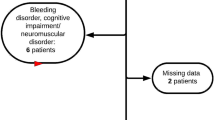Abstract
Purpose
This study aims to explore the prevalence of dysphagia, as well as mortality associated with dysphagia in the elderly population receiving surgical treatment for a hip fracture.
Methods
A retrospective cohort study was completed at an academic level 1 tertiary care center. Patients older than or equal to 65 admitted with a hip fracture diagnosis from January 2015 to December 2020 (n = 617) were included. The main outcome was the prevalence of dysphagia and association with mortality. Secondary analysis included timing of dysphagia and contributions to mortality.
Results
Fifty-six percent of patients had dysphagia, and the mortality rates were higher in patients with dysphagia (8.9%) versus those without dysphagia (2.6%), chi-square p = 0.001, and odds ratio 3.69 (CI 1.6–8.5). Mortality rates in patients with acute dysphagia were also higher (12.4%) than those with chronic dysphagia (5%) and chi-squared p = 0.02. Mortality rates in patients with a perioperative dysphagic event (13.9%) were higher than those with non-perioperative dysphagia (4%) and chi-squared p = 0.001. Mortality rates in patients who had acute perioperative dysphagia (21.2%) were higher than those with chronic dysphagia that presented perioperatively (6.8%) and chi-squared p = 0.006.
Conclusions
This study demonstrates high rates of dysphagia in the elderly hip fracture population and a significant association between dysphagia and mortality. Timing and chronicity of dysphagia were relevant, as patients with acute perioperative dysphagia had the highest mortality rate. Unlike other identified risk factors, dysphagia may be at least partially modifiable. More research is needed to determine whether formal evaluation and treatment of dysphagia lowers mortality risk.

Similar content being viewed by others
References
Brauer CA (2009) Incidence and mortality of hip fractures in the United States. JAMA 302:1573
Kazley J, Bagchi K (2023) Femoral neck fractures. StatPearls. StatPearls Publishing
Michael Lewiecki E et al (2018) Hip fracture trends in the United States, 2002 to 2015. Osteoporos Int 29:717–722
Swenning T, Leighton J, Nentwig M, Dart B (2020) Hip fracture care and national systems: The United States and Canada. OTA Int Open Access J Orthop Trauma 3:e073
Roberts SE, Goldacre MJ (2003) Time trends and demography of mortality after fractured neck of femur in an English population, 1968–98: database study. BMJ 327:771–775
Goldacre MJ, Roberts SE, Yeates D (2002) Mortality after admission to hospital with fractured neck of femur: database study. BMJ 325:868–869
Pelrine ER et al (2023) Evaluation of a 30-day-mortality risk calculator for patients undergoing surgical fixation of fragility hip fractures. Injury. https://doi.org/10.1016/j.injury.2023.05.058
Schnell S, Friedman SM, Mendelson DA, Bingham KW, Kates SL (2010) The 1-year mortality of patients treated in a hip fracture program for elders. Geriatr Orthop Surg Rehabil 1:6–14
Karres J, Kieviet N, Eerenberg J-P, Vrouenraets BC (2018) predicting early mortality after hip fracture surgery: the hip fracture estimator of mortality Amsterdam. J Orthop Trauma 32:27–33
Madsen G et al (2020) Prevalence of swallowing and eating difficulties in an elderly postoperative hip fracture population-a multi-center-based pilot study. Geriatr Basel Switz 5:52
Love AL, Cornwell PL, Whitehouse SL (2013) Oropharyngeal dysphagia in an elderly post-operative hip fracture population: a prospective cohort study. Age Ageing 42:782–785
Morley JE (2015) Dysphagia and aspiration. J Am Med Dir Assoc 16:631–634
Namasivayam AM, Steele CM (2015) Malnutrition and dysphagia in long-term care: a systematic review. J Nutr Gerontol Geriatr 34:1–21
Meals C et al (2016) Identifying the risk of swallowing-related pulmonary complications in older patients with hip fracture. Orthopedics 39:e93-97
Byun S-E, Kwon KB, Kim SH, Lim S-J (2019) The prevalence, risk factors and prognostic implications of dysphagia in elderly patients undergoing hip fracture surgery in Korea. BMC Geriatr 19:356
Allen J, Greene M, Sabido I, Stretton M, Miles A (2020) Economic costs of dysphagia among hospitalized patients. Laryngoscope 130:974–979
Hu F, Jiang C, Shen J, Tang P, Wang Y (2012) Preoperative predictors for mortality following hip fracture surgery: a systematic review and meta-analysis. Injury 43:676–685
Sue Eisenstadt E (2010) Dysphagia and aspiration pneumonia in older adults. J Am Acad Nurse Pract 22:17–22
Ramsey D, Smithard D, Kalra L (2005) Silent aspiration: What do we know? Dysphagia 20:218–225
McCarty EB, Chao TN (2021) Dysphagia and swallowing disorders. Med Clin North Am 105:939–954
Adult Dysphagia. American Speech-Language-Hearing Association https://www.asha.org/Practice-Portal/Clinical-Topics/Adult-Dysphagia/.
Miller N (2013) Oropharyngeal dysphagia in an elderly post-operative hip fracture population. Age Ageing 42:679–681
Mateos-Nozal J, Sanchez Garcia E, Romero Rodríguez E, Cruz-Jentoft AJ (2021) Oropharyngeal dysphagia in older patients with hip fracture. Age Ageing 50:1416–1421
Funding
There was no funding for this study.
Author information
Authors and Affiliations
Corresponding author
Ethics declarations
Conflict of interest
The authors have no relevant financial or non-financial interests to disclose.
Ethical approval
Institutional Review Board for Health Sciences Research (IRB-HSR) approval was obtained prior to starting the study. The study did not require informed consent.
Additional information
Publisher's Note
Springer Nature remains neutral with regard to jurisdictional claims in published maps and institutional affiliations.
Rights and permissions
Springer Nature or its licensor (e.g. a society or other partner) holds exclusive rights to this article under a publishing agreement with the author(s) or other rightsholder(s); author self-archiving of the accepted manuscript version of this article is solely governed by the terms of such publishing agreement and applicable law.
About this article
Cite this article
Boyapati, R.M., Hoggard, T.M., Yarboro, S.R. et al. Dysphagia is associated with increased mortality risk after hip fracture surgery. Eur J Orthop Surg Traumatol (2024). https://doi.org/10.1007/s00590-024-03918-6
Received:
Accepted:
Published:
DOI: https://doi.org/10.1007/s00590-024-03918-6




